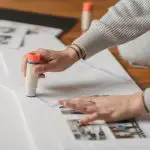To repair torn upholstery on your fabric furniture, start by cleaning and trimming the torn area. Choose a patch that matches your fabric’s texture and color, then sew the edges together with a strong needle and thread for durability. For quick fixes, fabric glue can hold small tears neatly. Align patterns carefully for a seamless look. Keep your furniture clean and away from direct sunlight to prolong repairs. Explore simple step-by-step methods next to restore your upholstery like a pro.
Table of Contents
Key Takeaways
- Clean and dry the torn area, then trim loose threads and smooth fabric edges for a neat repair surface.
- Choose a fabric patch matching the upholstery’s color, texture, and material for seamless blending.
- Use a strong upholstery needle and durable thread to sew the tear with tight, even stitches.
- Apply fabric glue or fray check along edges for extra reinforcement, especially on larger tears.
- Maintain repaired upholstery by avoiding sunlight, vacuuming regularly, and promptly cleaning spills.
Tools and Materials Needed for Upholstery Repair
Before you begin repairing torn upholstery, gather the essential tools and materials to guarantee a smooth process.
You’ll need a strong upholstery needle and durable thread that matches your fabric color to make sure your repair blends seamlessly. Fabric glue or a hot glue gun comes in handy for quick fixes or small tears. Keep a pair of sharp scissors nearby to trim loose threads and fabric edges cleanly.
If your upholstery has foam padding exposed, having some replacement foam or batting will help restore comfort. A seam ripper is useful if you need to remove stitching carefully.
Finally, consider using fabric patches or matching upholstery fabric to cover larger tears. Having these tools and materials ready will make your repair efficient and effective.
Preparing the Torn Area for Repair
Start by cleaning the torn area thoroughly to remove dirt and oils that could interfere with adhesion or stitching. Use a mild detergent and a soft cloth, then let it dry completely.
Next, gently trim any loose threads or frayed edges around the tear with sharp scissors to create a neat working surface. If the fabric is puckered or stretched, smooth it out carefully to restore its original shape.
For larger tears, consider using fabric tape or a temporary adhesive to hold the edges together while you work.
Finally, inspect the backing or padding beneath the tear; if it’s damaged or exposed, you may need to reinforce it before proceeding. Proper preparation guarantees your repair will be durable and look seamless.
Choosing the Right Fabric Patch
Selecting the right fabric patch is essential for a seamless and lasting upholstery repair. You’ll want to match the patch material closely to your furniture’s existing fabric in texture, color, and durability. Consider the fabric type, ease of application, and how well it blends with your upholstery style.
| Fabric Type | Durability | Best Use |
|---|---|---|
| Cotton Blend | Moderate | Casual furniture |
| Leather | High | High-traffic areas |
| Polyester | High | Stain-resistant needs |
| Velvet | Low to Moderate | Decorative accents |
Choosing wisely guarantees the patch won’t stand out or wear out quickly, giving your upholstery a fresh, professional finish.
Step-by-Step Guide to Sewing a Tear
Before you start sewing, make certain to trim and prepare the fabric edges for a clean finish.
You’ll also want to pick the right stitch technique to guarantee your repair holds up over time.
Let’s walk through these steps to get your upholstery looking good as new.
Preparing Fabric Edges
To prepare fabric edges for sewing a tear, you’ll need to carefully trim any frayed threads and align the torn pieces as closely as possible. This guarantees a clean, neat repair and prevents further unraveling.
Follow these steps:
- Use sharp scissors to trim loose or frayed threads around the tear.
- Gently press the fabric edges flat to align the torn parts evenly.
- Pin the edges together to hold them in place while you sew.
- Optionally, apply a small amount of fabric glue or fray check along the edges to reinforce them before stitching.
Choosing Stitch Techniques
Once you’ve prepped the fabric edges, it’s time to pick the right stitch technique to secure the tear. Your choice depends on the fabric type, tear size, and desired durability. For small tears, a ladder stitch works well, hiding seams neatly. Larger rips may require a whip stitch for extra strength. If the fabric is thick, try a backstitch to guarantee the repair holds up over time.
| Stitch Type | Best For | Strength Level |
|---|---|---|
| Ladder Stitch | Small, hidden repairs | Moderate |
| Whip Stitch | Larger tears | Strong |
| Backstitch | Thick fabrics, heavy use | Very Strong |
Pick the stitch that matches your tear’s needs to make your upholstery look seamless and last longer.
Using Fabric Glue for Quick Fixes
Although fabric glue isn’t a permanent solution, it offers a fast and effective way to mend small tears or loose seams in your upholstery.
You can use it when sewing isn’t an option or when you want a quick fix. Here’s how to apply fabric glue properly:
- Clean the area around the tear to remove dirt and oils.
- Apply a thin, even layer of fabric glue to the torn edges.
- Press the edges together firmly and hold for a few minutes.
- Let the glue dry completely, usually 24 hours, before using the furniture.
Techniques for Matching Fabric Patterns
Matching fabric patterns can make a huge difference in how your repaired upholstery looks. Start by carefully examining the original fabric’s pattern and orientation.
Carefully matching your fabric’s pattern and orientation is key to seamless upholstery repairs.
When cutting your patch, align the pattern so it flows seamlessly with the surrounding fabric. Use a fabric marker or chalk to trace the pattern lines on your patch before cutting.
If you’re working with stripes or plaids, match the lines precisely to avoid noticeable mismatches. For floral or intricate patterns, focus on lining up key elements to create a natural connection.
Always lay your patch on a flat surface and compare it to the damaged area before attaching. Taking these steps guarantees your repair blends in, keeping your furniture looking polished and professionally restored.
Tips for Maintaining Repaired Upholstery
Keeping your repaired upholstery in great shape requires a few simple habits.
To guarantee your furniture looks fresh and lasts longer, follow these tips:
- Regular Cleaning: Vacuum your upholstery weekly to remove dust and dirt that can wear down fabric fibers.
- Avoid Direct Sunlight: Keep your furniture out of direct sunlight to prevent colors from fading and fabric from weakening.
- Use Protective Covers: Consider using slipcovers or throws to shield your repaired areas from spills and stains.
- Prompt Spot Cleaning: Address spills and stains immediately with appropriate cleaning solutions to prevent permanent damage.
Frequently Asked Questions
Can Professional Upholsterers Repair Leather Tears as Well as Fabric?
When leather tears, professional upholsterers can work their magic like skilled surgeons, stitching and restoring it seamlessly. You’ll find they know exactly how to repair both leather and fabric, making your furniture look brand new again.
How Do Pets Affect the Longevity of Upholstery Repairs?
Pets can shorten your upholstery repair’s lifespan by scratching, chewing, or shedding fur. You’ll want to use durable fabrics and apply protective sprays to keep repairs intact and maintain your furniture’s look longer.
What Are the Environmental Impacts of Different Upholstery Fabrics?
You’ll find natural fabrics like cotton have lower environmental impact but might wear faster. Synthetic fabrics use more energy and chemicals but last longer. Choosing eco-friendly upholstery helps reduce waste and pollution overall.
Are There Any Upholstery Repair Kits Suitable for Beginners?
Imagine stitching a small tear with ease—yes, beginner-friendly upholstery repair kits exist! They come with simple tools, fabric patches, and clear instructions, letting you confidently fix your furniture without any prior experience or frustration.
How Often Should Upholstery Be Inspected for Potential Repairs?
You should inspect upholstery every 3 to 6 months to catch wear early. Regular checks help you spot tears or stains promptly, preventing bigger damage and keeping your furniture looking great longer.
- Nonwoven Polypropylene Safety: A Full Breakdown - July 11, 2025
- Care Instructions for Nonwoven Fabrics: Washing and Drying - July 11, 2025
- The Difference Between Woven and Nonwoven Wallpaper Explained - July 11, 2025







